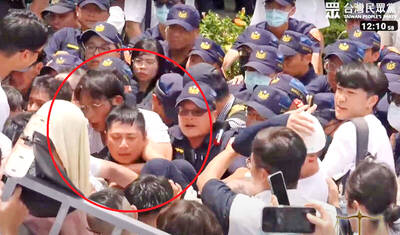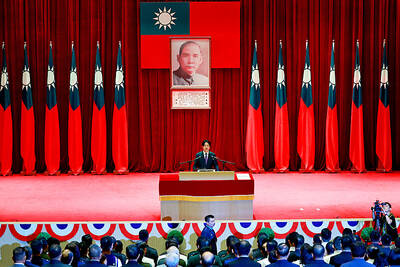All 112 people aboard a Chinese jetliner that crashed into the sea off China's northeast coast are dead, the airline announced yesterday, as rescuers in boats gave up their search for survivors that had lasted through the night.
The China Northern Airlines plane, on a domestic flight from Beijing, crashed late Tuesday just short of its destination in Dalian, a major port city.
"The 103 passengers and nine crew aboard the airliner all perished," said a letter by the airline that expressed condolences to the families of the dead.
Rescuers have recovered 66 bodies, most of them torn apart in the crash, said Shan Chunchang, deputy director of the national State Administration of Work Safety Supervision. He said a dredge is being used to bring up wreckage submerged under 11m of water.
"Our recovery efforts are made even more difficult because most of the corpses and most of the wreckage disintegrated," Shan said at a news conference.
Authorities said they were still looking for the plane's black box flight data and voice recorders.
The McDonnell Douglas MD-82 went down at 9:40pm about 20km from the Dalian airport after the pilot reported a fire, the official Xinhua News Agency said.
The majority of passengers were Chinese, China Northern said. It said eight of those aboard were foreigners -- three Japanese and one each from Singapore, India, France, Hong Kong and South Korea.
A policeman at an oil pier said he saw the plane flying in low circles just before the crash.
"I saw flame and light in the cabin," said the policeman, who wouldn't give his name. He said the force of the impact was like an "earthquake on the sea" and caused waves that shook patrol boats tied up at the pier.

TPP RALLY: The clashes occurred near the Chiang Kai-shek Memorial Hall on Saturday at a rally to mark the anniversary of a raid on former TPP chairman Ko Wen-je People who clashed with police at a Taiwan People’s Party (TPP) rally in Taipei on Saturday would be referred to prosecutors for investigation, said the Ministry of the Interior, which oversees the National Police Agency. Taipei police had collected evidence of obstruction of public officials and coercion by “disorderly” demonstrators, as well as contraventions of the Assembly and Parade Act (集會遊行法), the ministry said in a statement on Sunday. It added that amid the “severe pushing and jostling” by some demonstrators, eight police officers were injured, including one who was sent to hospital after losing consciousness, allegedly due to heat stroke. The Taipei

NO LIVERPOOL TRIP: Taiwan’s Lin Yu-ting, who won a gold medal in the boxing at the Paris Olympics, was embroiled in controversy about her gender at that event Taiwanese boxer Lin Yu-ting (林郁婷) will not attend this year’s World Boxing Championships in Liverpool, England, due to a lack of response regarding her sex tests from the organizer, World Boxing. The national boxing association on Monday said that it had submitted all required tests to World Boxing, but had not received a response as of Monday, the departure day for the championships. It said the decision for Lin to skip the championships was made to protect its athletes, ensuring they would not travel to the UK without a guarantee of participation. Lin, who won a gold medal in the women’s 57kg boxing

The US has revoked Taiwan Semiconductor Manufacturing Co’s (TSMC, 台積電) authorization to freely ship essential gear to its main Chinese chipmaking base, potentially curtailing its production capabilities at that older-generation facility. American officials recently informed TSMC of their decision to end the Taiwanese chipmaker’s so-called validated end user (VEU) status for its Nanjing site. The action mirrors steps the US took to revoke VEU designations for China facilities owned by Samsung Electronics Co and SK Hynix Inc. The waivers are set to expire in about four months. “TSMC has received notification from the US Government that our VEU authorization for TSMC Nanjing

CHINESE INCURSIONS, SORTIES: President William Lai thanked military officers for shouldering the responsibility of defending the survival and development of Taiwan President William Lai (賴清德) yesterday said that aggression would inevitably fail, pointing — on the day before a mass military parade in Beijing — to the lessons from World War II and key victories Taiwan claims against Chinese forces in 1958. Taiwan has over the past five years repeatedly complained about heightened Chinese military activity including war games around the nation as Beijing steps up pressure to enforce territorial claims that Taipei rejects. Chinese President Xi Jinping (習近平), flanked by Russian President Vladimir Putin and North Korean leader Kim Jong-un, are to oversee a military parade in Beijing today to mark the